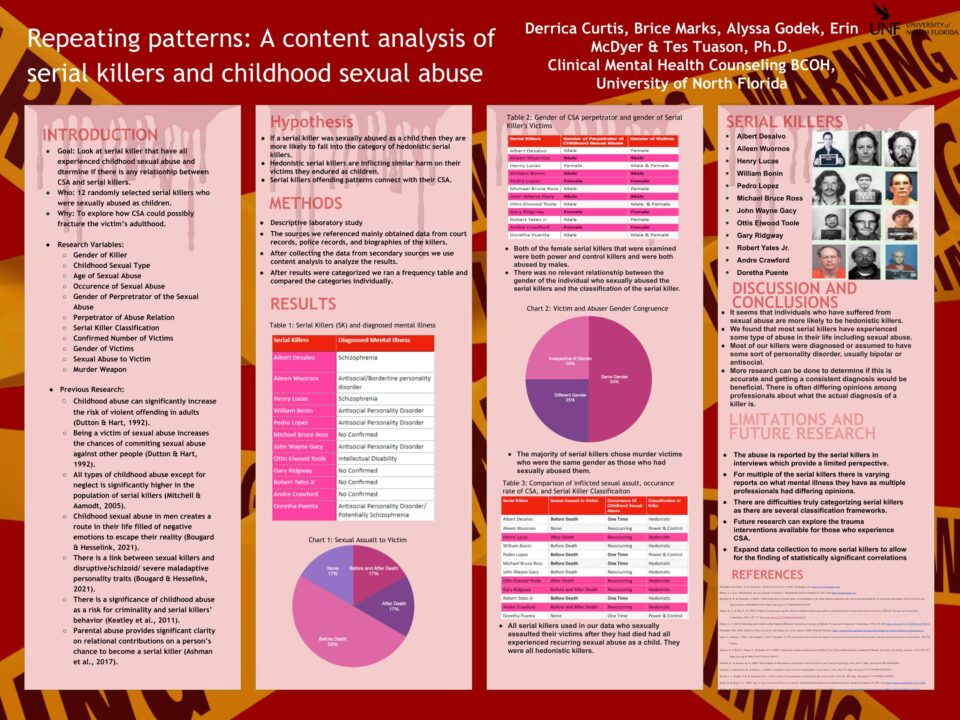Repeating patterns: A content analysis of serial killers and childhood sexual abuse.
- Graduate Student Research
- Copyright ©2022. Research projects are copyrighted by their authors. All rights reserved.
Abstract:
Hi, my name is Alyssa Godek and I am going to be presenting our research which is titled Repeating Pattern: a content analysis of serial killers and childhood sexual abuse.
There has been a lot of previous research done on serial killers and their experiences in childhood, specifically childhood abuse. It has been found that all types of childhood abuse, except for neglect, is significantly higher in the population of serial killers. Other previous research has found that being a victim of sexual abuse increases the chances of committing sexual abuse against other people. The purpose of our research was to explore each serial killer’s childhood and sexual trauma and see if there was any correlation between the type of murders they inflicted upon their victims.
We looked at 12 serial killers that have all experienced childhood sexual abuse to find how they relate, and any patterns of the violence and murder inflicted upon their victims that could possibly stem from their personal sexual abuse. We wanted to find out what type of killer category our serial killers who are sexually abused as children fall into. We also wanted to determine what traumatic childhood experiences serial killers had in common, whether or not childhood sexual abuse increases the chance of sexual violence in adulthood, and whether or not hedonistic serial killers typically suffer from a specific mental illness. Wee hypothesized that serial killers who were sexually abused as children were more likely to fall into the category of hedonistic serial killers. We also hypothesize that hedonistic serial killers were inflicting similar harm on their victim as the harm that they endured as children. We also hypothesize that hedonistic serial killers offending patterns connected with their childhood sexual abuse.
We separated sexual abuse into two separate categories. Our first category was psychological sexual abuse, which included sexual abuse in which physical contact did not occur. This included forcing the individual to watch pornography and being forced to watch a parent or adult having sex. The next category was physical sexual abuse, which was any instance of sexual abuse on which bodily contact was made with sexual intention. It is also important to note the classifications we used for our serial killers which were two of the classifications. These two classifications were hedonistic, which is a killer that kills for their own pleasure including rape torture and fame, and the other category was powering control killer who is the killer that fantasizes over having power over their victim and sought to take control over them. Additionally, we investigated the sexual assault to the victim, whether or not there had been any sexual assault, whether the assault had taken place before death, after death, or both. We also investigated the murder weapon that was used by the serial killer to determine whether or not the killing was intimate. Lastly, we also looked at the mental illness diagnosis of all of our twelve serial killers for our research.
We used social learning theory as many of the articles that we looked at had evidence that the trauma children endured made them more likely to partake in negative behaviors. Research also believes that the sexual abuse serial killers experience affects them cognitively behaviorally and environmentally which negatively shapes their behavior causing them to commit sexual killing of others. We also used critical theory as we were focusing on serial killers and their traumatic experiences.
We chose our twelve serial killers by sifting through sources to find serial killers who had experienced sexual abuse as children and then we randomly selected 12. We proceeded to find secondary data across various websites and scholarly articles, such as murderpedia.com and biography.com . The sources we reference mainly obtained data from court records police records and biographies of the killers. Information we gathered on the serial killers included the gender of the killer, the childhood sexual abuse type, the age of sexual abuse, the occurrence of sexual abuse, the gender of the perpetrators of the abuses , the perpetrator of abuses relationship, killing classification, confirmed number of victims, gender of victims, sexual assaults of the victim, murder weapons, as well as any mental illnesses the serial killer had been diagnosed with. We were looking for any correlations between and among these factors. With the help of this study, we would like to educate others on the experiences of serial killers’ childhoods and challenge the myth that traumatic childhood experiences do not play a very significant role in the outcome of adult’s lives. After collecting the data from secondary sources, we used content analysis to analyze the result. Two individuals independently classified and categorized the variables gathered from secondary data in order to increase reliability of the results. After the results were categorized, we ran a frequency table and compared the categories.
Ethical considerations that were taken into account while doing this research was that we did not want to portray the results as meaning that if you were sexually abused as a child, you were likely to become a serial killer. We also do not want to justify the actions of the serial killers, and we did not want to stigmatize mental illness.
Results showed that all serial killers used in our data who sexually assaulted their victims after they had died had all experienced reoccurring sexual abuse as a child. They were all hedonistic serial killers as well. More research needs to be done to confirm this, but it seems as though there may be a correlation between the two. The majority of serial killers chose murder victims who were the same gender as those who had sexually abused them. This indicates that there may be a more aggression towards the gender that leads them to commit murder. There was no relevant relationship between the gender of the individual who sexually abuse the serial killer and the classification of the serial killer. Both female serial killers that were examined were both power and control killers and both were abused by males. Further research may find a greater correlation between female serial killers and the type of killer they are based on the gender of the abuser. Our results showed that if there was no sexual assault on the victim the type of killing was usually less intimate. There was a higher likelihood of more intimate killings if there was sexual assault. Also, a higher frequency of the killers using either multiple methods or solely intimate methods of killing and being a hedonistic killer. With the exception of only two serial killers the killings began between the ages of 25 and 35. Only one of our killers used intimate killing and were power and control killers and all except for one of our killers used non automatic weapons to kill victims. Our research seems to show that individuals who suffered from sexual abuse are more likely to be hedonistic killers it is, however, difficult to truly categorize our killers beyond the basic labels of hedonistic, power and control, visionary, and mission-based killers. Some killers present as more than one and make subcategories more difficult to place on killers. Making clear definitions and agreement between criminal profiles may make the categorization process more accurate. We also found that most serial killers have experienced some type of abuse in their life including sexual abuse. There are some exceptions to the rule, however, we are basing this on the killer’s perspective in life so there may be some reliability issues. We also must keep in mind that most of our serial killers are no longer alive to be further interviewed. We found that most of our killers were diagnosed or seem to have some sort of personality disorder, usually either bipolar or antisocial personality disorder. More research should be done to see if this is accurate and consistent diagnosis would be beneficial because there’s often differing opinions among professionals about what the actual diagnosis of the killer is. Court based psychiatrists and other doctors had varying diagnosis that make it difficult to point out what the actual diagnosis was for the serial killers.
Our hypothesis that serial killers who were sexually abused as children were more likely to fall into the category of hedonistic serial killers was correct according to our research, however, more research must be done to confirm this. Our other hypothesis, that hedonistic serial killers were inflicting similar harm on their victims as the harm they experienced as a child, was also proven correct according to our results. This is potentially true as all our male serial killers inflicted sexual assaults on their victims. Two of them committed the assault after death, and two committed the sexual assault before and after death. However, this does not apply to our female serial killers as they prefer to harm their victims physically instead of sexually. Our last hypothesis that serial killers offending patterns connect with their childhood sexual abuse was also confirmed as most of our serial killer’s victim typology was the same as her childhood sexual abuse perpetrator.
Thank you for listening!



4 Responses
So very happy of all the hard work you put into conducting your research. I am very proud of the group process you went through, and proud of the yields of your research: the patterns of childhood sexual abuse and the impact on the type of serial killer, the harm they inflicted on their victims, and the victim typology.
Happy to see you present in SOARS 2022!
This is such an interesting topic, and the depth explored for this topic is remarkable. An area many would not dare to explore, and i commend you all for doing do.
This is a very interesting topic and worthwhile research for prevention and early intervention initiatives for children who experience abuse.
Great job everyone!! This study was super interesting. I think the topic of childhood trauma is an important one that needs to be addressed because it can have significant implications for someone’s life, particularly in addition to other mental disorders